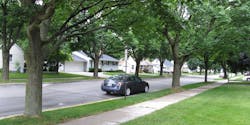Links Between Neighborhood Type and Health
A new study finds that trees are a key factor in how neighborhoods affect residents’ health.
A group led by Adriana Zuniga-Teran, a postdoctoral research associate in the University of Arizona’s Udall Center for Studies in Public Policy, wrote a journal entry titled “Neighborhood Design, Physical Activity, and Wellbeing: Applying the Walkability Model.”
Based on a survey of 380 people in Tucson, Ariz., the report examines how four common neighborhood designs—traditional developments, suburban developments, gated communities, and cluster housing—affect residents’ physical activity habits and mental wellness.
Zuniga-Teran surveyed residents of each of the four styles of neighborhood. Respondents were asked about the prevalence of local crime, their walking routines, their interactions with neighbors, and the amount of green space in their community.
Residents of low-density suburban developments were found to have the highest levels of mental well-being. Even with the annoyances of suburbia (long commutes, reliance on automobiles, and a lessened sense of community), the group benefits from local green spaces. Zuniga-Teran said that large lots and trees buffer noise, lower stress, and provide a level of privacy and security.
Cluster housing, such as townhome communities, gain the same advantages from green spaces. Since homes are packed in tight, residents also have greater connection with their neighbors and their community. They talk more and feel a stronger sense of safety.
People did the most walking, both for recreation and transportation, if they lived in mixed-use traditional neighborhoods where homes are situated on an urban grid with nearby stores, restaurants, and other necessities and attractions. But, Zuniga-Teran found that residents of traditional neighborhoods had higher perceptions of crime, in part due to exposed trash, litter, and graffiti.
Gated communities didn’t score well in any particular category. “They did not score the highest in anything, not even perceived safety, which is kind of odd because they close themselves out for safety reasons,” Zuniga-Teran said in a statement.
Trees were the common thread for well-being. Zuniga-Teran said that more trees lead to a higher perception of safety, contribute to a better walking experience, and foster interaction between neighbors.
